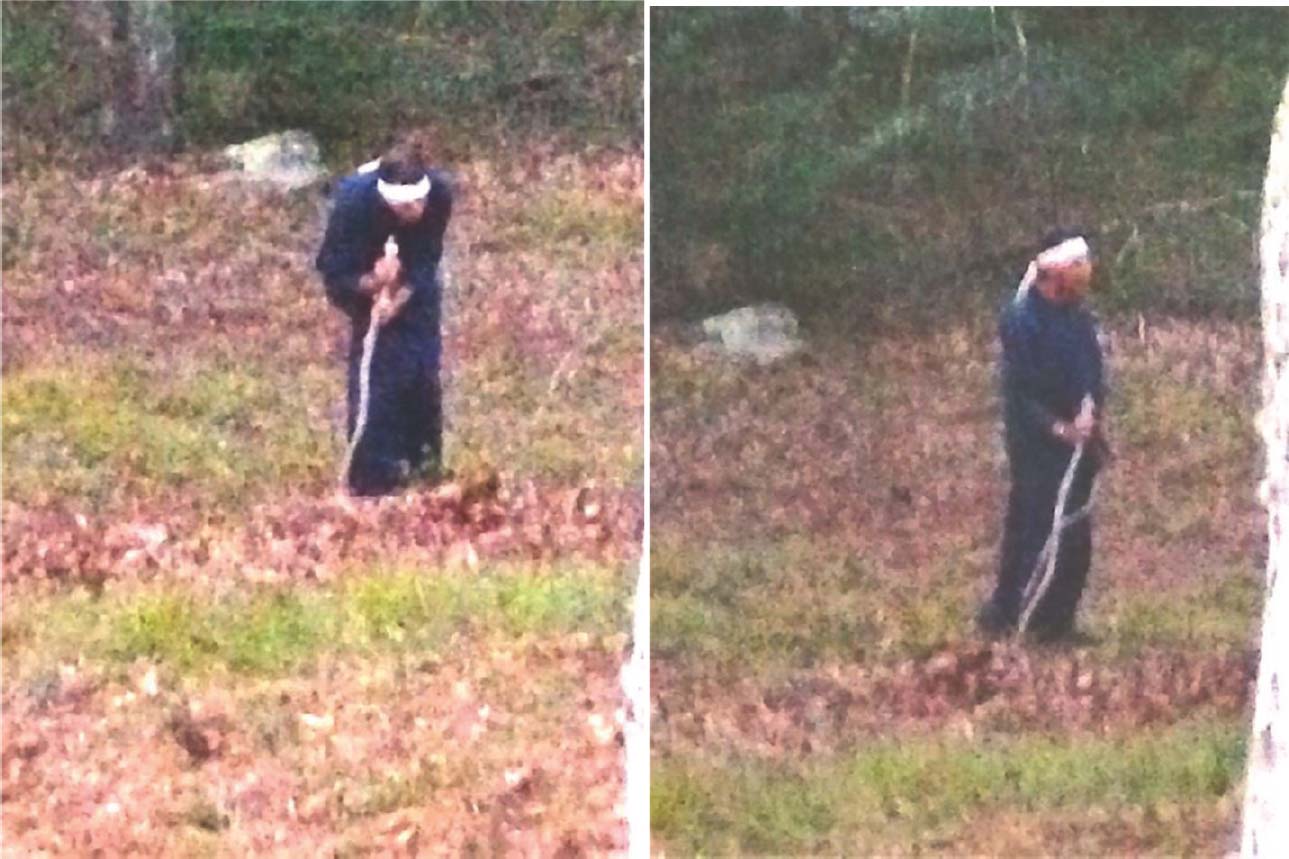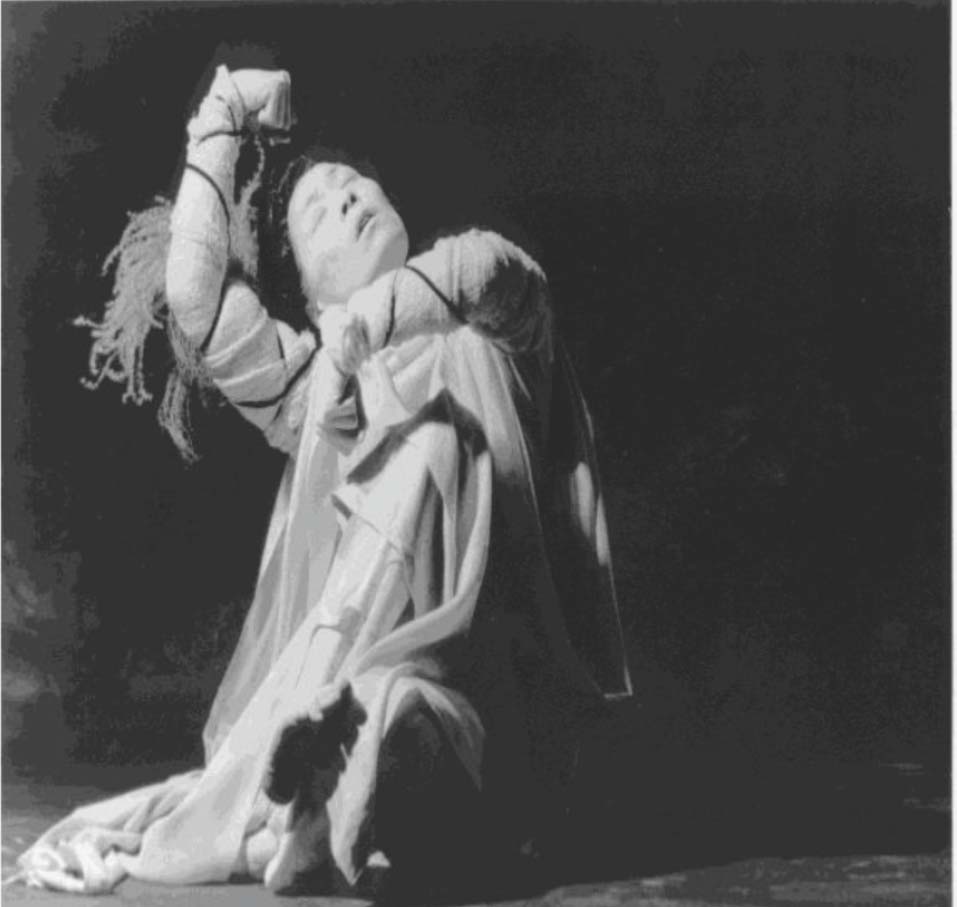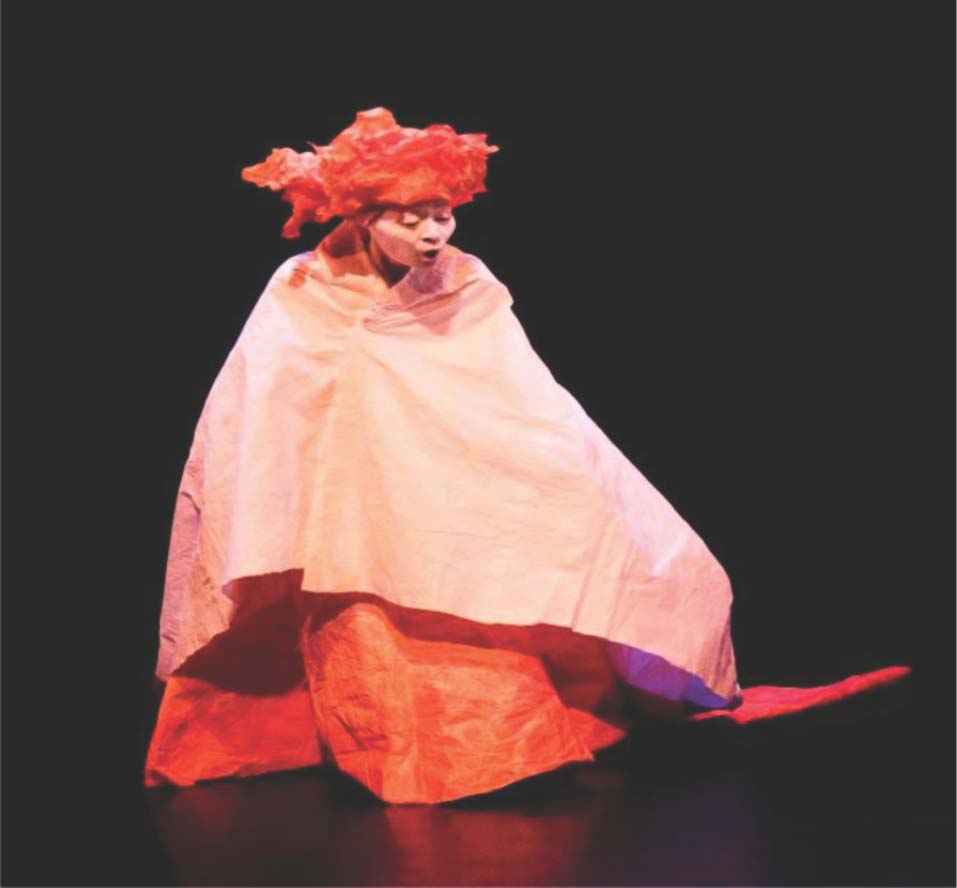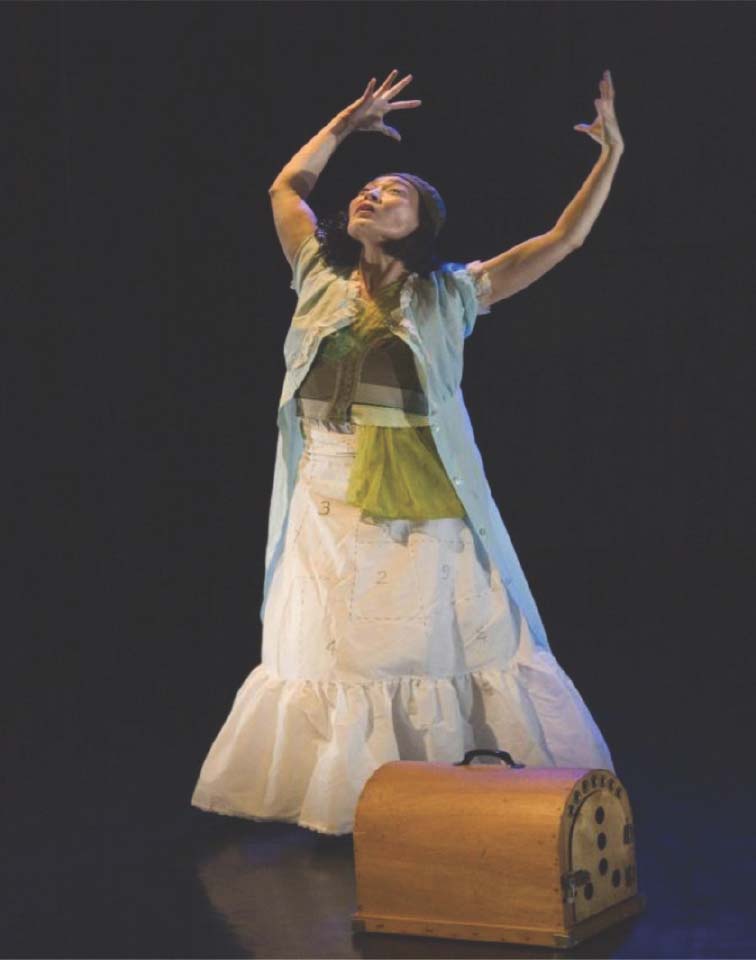
| Creative Arts Educ Ther (2016) 2(2):40–48 | DOI: 10.15534/CAET/2016/2/14 |
Featured Artist – Denise Fujiwara
Butoh: Dance of Transformation
An Interview conducted by Stephen K. Levine in Toronto, Canada, September 2016.
艺术家聚焦 - Denise Fujiwara
舞踏:转化之舞
2016年9月,加拿大多伦多,Stephen K. Levine采访Denise Fujiwara
The European Graduate School, Switzerland
Abstract
The following is the text of an interview with Denise Fujiwara, a Japanese-Canadian Butoh dancer, choreographer, and teacher, who is our Featured Artist for this issue of the CAET journal, preceded by a short account of a Butoh performance by Stephen K. Levine in 2016. Fujiwara talks about her background and training, and introduces several key principles of Butoh, including that of ma, the space in between. Butoh is understood as a dance of transformation, rooting the performer and spectator in the body and its relationship to nature and the elemental.
Keywords: Denise Fujiwara, Butoh, dance of transformation, post-war Japanese culture, postmodern Western dance, improvisation, ma, emptiness, presence, the elements, not-knowing
摘要
以下内容是Denise Fujiwara接受采访的文本。她是日裔加拿大舞踏表演艺术家、编舞和舞蹈教师,同时也是CAET期刊本期的特色艺术家。 Denise谈到她的背景和训练,并介绍了舞踏艺术的几个关键原则,包括“ma”,其间的空间。舞踏被认为是一种转型的舞蹈,把表演者和观众植根于身体中,以及它与自然和元素的关系中。 采访文本之前是采访者在2016年夏天的舞踏表演的描述。
关键词: Denise Fujiwara,舞踏,转化之舞,战后日本文化,后现代西方舞蹈,即兴,ma,空无,存在,元素,无所知
Start from the Place of your Handicap
–Yoko Ashikawa
The dancer is standing at the bottom of the hill, with his back to the audience. He slowly turns around, sees the beauty of the natural setting and welcomes it. Very slowly, he begins to move up the hill, stumbling and recovering balance as he goes. As he does so, he embodies different states of being: the child discovering what is around him, gradually growing into his sexuality, then becoming aware of his capacities and going forward into life. Along the way, the man encounters injustice and rails against it. Finally, as he grows older, he begins to surrender and accept what is–in the world and in himself. In the end, his body seems to shrink into itself. He picks up a stick and, leaning on it, slowly makes his way out of the scene, vanishing from sight behind a large rock.

The above is a description of a Butoh performance I did on my 78th birthday, four months after fracturing my pelvis in a bicycle accident. Butoh (“dance step”) is a post-war form of Japanese dance/theater. I have been studying it with my teacher, Denise Fujiwara, our Featured Artist, for a number of years. Butoh emerged out of the chaos of post-war Japan. Its founder, Tatsumi Hijikata, was searching for a quintessential Japanese mode of expression, something that would fit the “Japanese body”–a phrase I take in its widest sense to mean not only the physical body but the body of culture and history which had been shattered in the wake of the war. At the same time, Butoh can be situated in an intercultural setting: it was strongly influenced by the Neue Tanz of Mary Wigman and by the expressionist and surrealist movements in Europe, themselves drawing upon ukiyo-e, the Japanese wood carvings of the nineteenth century (Fraleigh, 2010).
Nevertheless, Butoh has a character of its own. As opposed to much of European dance, with its quick movements reaching up and out, Butoh is characteristically slow, orienting itself in and downwards, as if it were striving to touch the inner core of the self and the earth. In its original form, as developed by Hijikata, it can seem grotesque and distorted–Ankoku Butoh, a ”dance of darkness” expressing all that is covered over by our civilized life, finding not only pain and suffering but also a form of redemption in surrendering to what is. As Butoh developed, especially under the influence of Kazuo Ohno, Hijikata’s earliest collaborator, it also showed a spiritual dimension, revealing light and grace in the face of what Joseph Conrad called, “The horror! The horror!” In its further development as an international dance form, Butoh joined with American post-modern dance, with its emphasis on improvisation and playfulness. Perhaps there are no pure forms, neither in dance nor in life.
To my mind, the essence of Butoh is transformation, taking what has been insulted and injured, that which we normally cover over out of shame, and bringing it into the light of day, revealing beauty in all its forms. As such, Butoh is aligned with those creative and expressive arts therapies which find space and light in the cramped and dark places of the soul. It was in this spirit that I performed the dance described above. I offer it to the reader in honor of my teacher, Denise Fujiwara, who inspired me to start from the place of my handicap.
Steve: You’re known primarily as a Butoh dancer, teacher, choreographer and director, but you were a gymnast first, I believe.
Denise: Yes, I was an athlete. When I was a young child, my parents moved from downtown Toronto to the suburb of Scarborough. It seemed fairly desolate, but it turned out that the Canadian Gymnastic Team trained at the local high school. My sister and I auditioned for this club and were accepted. We received elite gymnastic training; my sister became Junior National Champion. I was injured and switched to rhythmic gymnastics and was a Canadian champion, competing internationally for Canada for a number of years.
In my teens, my very spirited mother performed in a modern dance company. I saw a lot of modern dance and that introduced me to the idea that I could go beyond my gymnastic training, and use movement to be articulate and expressive and actually say something about the world we live in.
I went into the dance program at York University and practiced classical ballet, modern and contemporary dance techniques. I was also introduced to American post-modern improvisation methods. My favourite subjects, however, were my courses in Anthropology and East Asian Studies.
Steve: When you graduated, what happened?
Denise: Before I graduated, a number of us started a dance company called TIDE (Toronto Independent Dance Enterprise). It was really a collective of choreographers who were all interested in the creative process as much as we were interested in creating repertoire. For me, it was a hot-house for learning, experimenting, creating, critiquing and dancing for the eleven tumultuous years that it existed. During that time we focused a lot on post-modern American dance improvisation like contact improvisation and other related kinds of work. We brought in great teachers like Nancy Stark Smith and Lisa Nelson. We were also interested in dance theatre, and consequently we worked with people like Anne Bogart from the theatre world. On my own, I studied intensively with the San Francisco company, Mangrove, which integrated all of those approaches into their performance work.
FIGURE 1 | Work: Sumida River, Choreographer: Natsu Nakajima Performer: Denise Fujiwara Photographer: Cylla von Tiedemann
For links of the work https://www.youtube.com/watch?v=-fkiUr8QhyQ

FIGURE 2 | Work: Komachi, Choreographer: Yukio Waguri Performer: Denise Fujiwara
For links of the work https://www.youtube.com/watch?v=VaKl2Tc6eJ0

FIGURE 3 | Work: Lost & Found Choreographer & Performer: Denise Fujiwara
For links of the work https://www.youtube.com/watch?v=SzN5g-vPOYI&feature=related

Denise: I saw Butoh a number of times during this period, the 80’s. They were all male performers and I wasn’t particularly drawn to pursue Butoh until I saw Natsu Nakajima. She performed her work Niwa. I was riveted by the sensitivity, maturity and complexity that was embodied in the content of her choreography and in her performance. She expressed a profound and life-affirming humanity through her work.
Natsu was involved in Butoh almost from its beginning. She began working with Kazuo Ohno when she was around 18 years old and then went on to work with Hijikata. So she was very fortunate to come from two lines of development from the most important founders of Butoh. She received the wisdom and possesses the qualities of both of those teachers and choreographers. She is a luminous performer, a very creative improviser, strong in the structural aspects of choreography and a gifted designer.
Steve: I believe you worked with Natsu for over 15 years. What was it like to work with her for so long?
Denise: I worked with her in short intensive periods over that time. In 1994 she made a solo for me called Sumida River in five weeks of intensive work. Several years later she revised the work and let me rework a section of the dance. I would say that it really took a few years to assimilate the very basic principles that make Butoh such a unique dance. It took about ten years of performing it to deeply embody the refinements that she embedded in the choreography. Over the years she challenged me to exceed my limitations and to grow my artistry in many ways. Her own artistic mastery and brilliance have always been a huge inspiration.
Steve: Can you say something about the principles that she was teaching you?
Denise: The principles of Butoh are diametrically opposed to the principles that I had learned as a contemporary dancer. My training in contemporary dance, ballet and modern dance had taught me anatomically correct technique, given me strength and flexibility; and my post-modern American improvisational dance training taught me a lot about being focused and aware. But I found that when I was working with Natsu, none of those things were very useful. I was suddenly in a different paradigm. It was disorienting, terrifying actually, to realize that I was going to fail over and over again and that I didn’t know much about dance from the perspective that she was leading me into. The work necessitates a constant state of creative presence to create an inner life that is so potent that it is exposed through the very presence of the dancer, to reveal the dance.
Steve: I have a sense that the techniques you had learned before you explored Butoh could be called “Western” dance, and here we have something which is more “Eastern.” I know these terms are contentious and have multiple meanings, but it does seem to me that Butoh is very Japanese.
Denise: Butoh is atavistically Japanese but is now practiced all over the world. In his research, Hijikata went back to the beginnings of the ideas of dance and theatre in Japan. He was interested in human nature and wanted to find a form appropriate for the Japanese body. His research led him to shamanic and primal conditions of the body. Most Japanese arts are saturated with Zen ideas and Butoh is no exception. For example, Hijikata said that if you want to do Butoh, the first thing you must do is kill the self. From Zen we learn that we have no self. We work to let go of personality, to get out of the way so that something more universal can appear as the dance. You might also look at this from the perspective of emptiness. If you look at the concepts of “no self” and “emptiness” from the Western psychological perspective, those could be considered unhealthy instructions, because in Western psychology to be empty is generally considered not to be a good thing. Rather, one is encouraged to develop a strong sense of self. Emptiness in Zen is something positive, an acknowledgement of the interrelatedness of all things and a state that opens us to potential.
Steve: When you were growing up, was it in a strong Japanese culture? Were your family first- or second-generation Canadians?
Denise: My parents were born in Canada. They were among the Japanese-Canadians interned during the World War II. After the war was over, they were not allowed to move back to their homes on the coast of British Columbia. They were uprooted and relocated as labourers in other provinces. I grew up thinking I was Japanese because we were not accepted as Canadian. I grew up with a sense of urgency to assimilate, to disappear into Canadian culture. My parents spoke Japanese at home and did plan to send us to Japanese language school, but that was exactly at the same time we got the opportunity to pursue the elite level gymnastic training, so the Japanese language school plan went out the window.
I think that language is a very big part of understanding a culture, and I am sorry that I didn’t get to pursue it. In fact I chose to practice Butoh as a way to learn about and embody my Japanese heritage as an alternative to learning the language. I am always curious about the Japanese words that have no exact English translation. I think those kinds of words are keys to understanding a culture. What I encountered in Butoh, are many of those ideas and words for which there are no easy English equivalents. They taught me a lot about the essence of Butoh and my Japanese cultural heritage.
Steve: I remember from your workshops that one of the concepts that you talked about a lot was the concept of ma. Can you say a little bit about that?
Denise: Ma was a word that Natsu introduced me to, in the creation of Sumida River. She said that I had to have ma in order to be able to perform the piece properly. This was a new word for me. The dictionary’s definition is ‘the space-time in between,’ but this doesn’t explain its profundity. Ma is a quality that is highly valued in Japanese art. You see it in the empty spaces in a painting, what in the West we might call negative space, but it’s much more than that. When we apply it to Butoh, it refers to the ability of the choreographer and the dancer to expand and contract space-time. It took me a long time to figure out how to manifest that in performance.
Steve: It seems to me to have a lot to do with presence.
Denise: Presence is a component of how one expresses ma in performance. I think that it’s really cross-cultural, something you find in good art everywhere in the world. It’s just not recognized as ma in other cultures. It’s kind of invisible but you know it when you experience it. It’s not something that you can see and point out, it’s something that you experience, so that’s perhaps why we don’t have a word for it in English, because you can’t see it. When there is ma, it is something that you experience and others can experience by watching you. People often identify Butoh with a tendency to move very slowly but that in itself is not ma.
In Butoh, moving very slowly can be fascinating and timeless. It’s not the slowness that’s engaging. It’s that the performer and the choreographer have created ma.
Steve: I have a sense that the elements are important to Butoh. Certainly in your classes we often embody different elemental states–earth, air, water and fire–and we often engage in embodying mud as a primary material, in the sense of going back to some primordial state of being that is pre-civilized. Is that fair to say?
Denise: Hijikata was very interested in the question of what is human before enculturation and so that led him to explore these kinds of pre-civilized states of being which are, among other things, elemental.
Steve: Is that important for you?
Denise: I’ve found it to be a very powerful exploration. I was also introduced to dancing elemental states through my post-modern improvisation training. I have pursued this exploration of elemental states and qualities in a way that merges these two paths, to find many ways of embodying primordial states of being through movement.
Steve: I think that’s similar to certain tendencies in therapy, for example, in expressive arts therapy where we try to go below the interpretive frameworks in which psychology operates and experience something more primordial. Working through the body becomes a way of knowing. It feels like there is a therapeutic aspect in Butoh that was not intended but, depending on how it’s approached, can have a therapeutic effect. Wasn’t Hijikata looking for some means of transformation?
Denise: Yes, I believe that transformation was a central idea for him.
Steve: Sondra Fraleigh in her book talks a lot about metamorphosis and transformation in Butoh. She describes it as an alchemical process.
Denise: The experience of dancing Butoh can be transformational. For Butoh to be transformational, it’s really important to have a good teacher who deeply understands the art and skills and can transmit that to the performer in order to bring about the conditions for internal transformation, the kind that will blossom in the performer in such a way that it can be made visibly and viscerally sensible to the audience.
With respect to what might be therapeutic about this work for a practicing Butoh dancer is that it encourages you to always to be in the present. It’s a living practice in Buddhist psychology, because we practice to be present in our bodies in movement and to let go of mental attachments. Some aspects of the work are contemplative and can be like moving meditation. We have a way of practicing where one learns to forget the self in a physical way. Those are very healthy things. I notice that when we practice these things the students feel creative and open and happy. It makes me feel those things too, and that’s really why I continue to pursue this work.
Steve: Let’s go back to your development as a performer and choreographer. It seems to me that you’ve managed to bring a lot of your post-modern dance training into your work.
Denise: I am really grateful to have been given training and performance experience under the masterful Butoh artist, Natsu Nakajima. She is brilliant and uncompromising. I was able to immerse myself deeply in Sumida River for 12 years. That time allowed me to continue to deepen my understanding of how to realize it. It and Natsu gave me a deep foundation as a choreographer and performer. In my own choreography I constantly draw on that deep knowledge I received from and through her.
My own choreography now is very much a confluence of Butoh and post-modern Western improvisation ideas. At first, these seemed like oil and water but now they’ve merged and I cannot separate them. From the postmodern improvisation practices I especially value the ideas of Anna and Lawrence Halprin around crafting improvisation scores using egalitarian principles. This remains important to me.
Steve: You have had a long career in which your work has developed and matured. What are you working on now?
Denise: Every Butoh artist interprets what is Butoh in their own way. In that respect I’m not different. When I develop a piece of choreography I use whatever will serve the work and allow me to express the ideas of the content of the work. Consequently my work looks very different from one dance to the next.
Steve: Do you have a sense of where you are going in the future?
Denise: I have no idea. I believe in the Zen idea that we can only be in the present and what lies before us is unknown. Here is a Zen koan to end our conversation: “Not knowing is most intimate.”
About the authors
Stephen K. Levine, Ph. D., D.S.Sc., REAT, Dean of the Doctoral Program in Expressive Arts in the Division of Arts, Health and Society at The European Graduate School (Switzerland), Professor Emeritus at York University (Toronto). Email: stephen.levine@egs.edu
Denise Fujiwara, with an Honours B.F.A. in Dance at York University, is a Japanese-Canadian Butoh dancer, choreographer, teacher, and one of the founders of T.I.D.E. (Toronto Independent Dance Enterprise). Fujiwara’s approaches to the disciplines of dance technique, improvisation, performance and choreography have developed over more than three decades of intensive research, practice and performance.
References
Fraleigh, Sondra (2010), Butoh: Metamorphic Dance and Global Alchemy. Urbana, Chicago, and Springfield: University of Illinois Press.
Website Denise Fujiwara:www.fujiwaradance.com